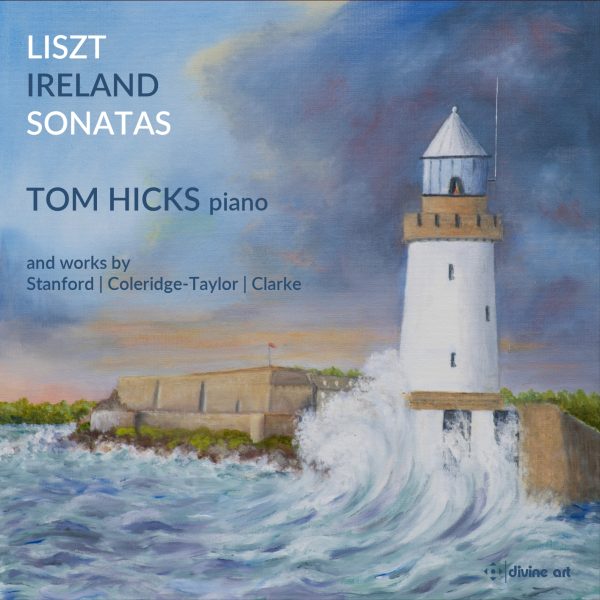Tom Hicks is a US based British pianist still in his twenties who was trained in Manchester before continuing his studies in Yale with Boris Berman ad Chicago with James Giles. This is his debut disc on the Divine Art Label and shows him to have unusual priorities: Tellingly sensitive voicings, a desire to always produce warm, reserved but glowing tone at all levels and rhythmic and articulative control are leitmotifs running through every phrase played. Hicks is mindful never to over-spill technically into carelessness. Listening to his performances of the Ireland sonata (such a gloriously positive valediction after the end of World War 1) and the Liszt B minor (apparently there are currently around 200 alternative versions of this in the catalogue!) always feels safe and satisfying. One could never imagine this player to panic, lose control or focus. Dependable playing that would surely thrive under the live pressures of any international competition or broadcast, no matter how high profile.
Priorities in this performance of the Liszt B minor Sonata are very much to produce clear and focused sounds on literally every semiquaver. Hicks certainly takes the concept of separating the three upbeat triplets from the five repeated quavers in the ‘mephisto’ motif throughout the sonata seriously- every time. Rarely have I heard a performance in which literally all the notes emerge with indisputably pristine focus. Clarity is the word! In terms of sonic significance, the biggest moments in both sonatas emerge with remarkable resonance. One could never imagine demonic angst, percussive ugliness, or thoughtless abandon to pour forth from this pianist’s finely developed digits. But Hicks is most certainly capable of reserved spell-casting too, and this is most tellingly realised in Samuel Coleridge-Taylors’ intimately charming ‘op. 71 no. 2 ‘Three-Fours’ waltz- surely the highlight of the disc in terms of communicative conviction.
Those in search of demonic abandon, ‘safety last’ and even long seamless melodic lines in which beats and bar lines dissolve, may be rather disappointed. Hicks never allows his pulse to quicken too much. He does not allow himself to get even moderately intoxicated. But there is no shortage of alternative versions of either sonata if you are after this sort of thing! As for the programme content, there is much here to stimulate thought. Using a teacher-pupil thread to connect miniatures with two substantial sonatas produces a highly listenable, contrasted, and intriguing recital, recorded most sympathetically in Guernsey last year on a piano which may not be the newest-but which certainly exudes a quaint charm.
I found the sound quality and occasional tuning issues with the instrument strong pluses in listening: Here is a complete antidote to the clinical perfectionism that can be presented in modern recordings where the emphasis is on cleanliness and order rather than on evoking a sense of a live event. I was reminded of one of the issues on the Divine Art Label in this respect, ‘The Scottish Romantics’ (DDA 25003) in which a piano most certainly past its best years nonetheless enhanced rather than jeopardised the nostalgic Victorian charm present in music by Sir Alexander Mackenzie, Hamish MacCunn, and John Blackwood MacEwen.
Perhaps in hindsight it would have made more sense for the Frank Bridge sonata (or the un-recorded Mackenzie Fantasy) to have been included here instead of the Liszt, but that it not to take away from a highly stimulating and individual recorded recital that will give much pleasure and food for thought.
@divineartrecordingsgroup
A First Inversion Company
Registered Office:
176-178 Pontefract Road, Cudworth, Barnsley S72 8BE
+44 1226 596703
Fort Worth, TX 76110
+1.682.233.4978










![Listen to the full suite of Marcel Dupré’s Variations Sur un Noël, Op. 20 from Alexander Ffinch’s #Expectations release today! listn.fm/expectations [in bio]](https://scontent-dfw5-1.cdninstagram.com/v/t51.71878-15/588904367_2327488161082898_8709236950834211856_n.jpg?stp=dst-jpg_e35_tt6&_nc_cat=105&ccb=7-5&_nc_sid=18de74&efg=eyJlZmdfdGFnIjoiQ0xJUFMuYmVzdF9pbWFnZV91cmxnZW4uQzMifQ%3D%3D&_nc_ohc=H8WFKm530VcQ7kNvwGIamXN&_nc_oc=AdkCU0bHzQ_0XTKomMoPppVnXnL1o2Frx1p2Wu6t5LBXNQzH6Wl0TsxZ8qP8dary_oI&_nc_zt=23&_nc_ht=scontent-dfw5-1.cdninstagram.com&edm=ANo9K5cEAAAA&_nc_gid=SPTFzkrIOD6SSyDEeWIBtg&oh=00_AflfQX8dJ2PQlRfOf-cE5S6uiLcUQ78cXG8yrNvtzs9pew&oe=695530EA)

![“the ‘Manteca’ Paraphrase – a rare foray into the two-piano medium but here played double-tracked – exudes a panache of which Dizzy Gillespie would surely have approved.… [a] recital well worth investigating.” —Gramophone Magazine with high praise for Ophelia Gordon's debut release, Kapustin: Between the Lines!](https://scontent-dfw5-3.cdninstagram.com/v/t51.82787-15/598796470_18303255136283342_540941604740887837_n.jpg?stp=dst-jpg_e35_tt6&_nc_cat=108&ccb=7-5&_nc_sid=18de74&efg=eyJlZmdfdGFnIjoiRkVFRC5iZXN0X2ltYWdlX3VybGdlbi5DMyJ9&_nc_ohc=IC4zZ7tcpb8Q7kNvwExli9l&_nc_oc=AdkjWertDMestob1858EBfq-ZPSKTc3bZmsrCEnRSML_lEfnhcAUU0oX3XgJxqDYQq0&_nc_zt=23&_nc_ht=scontent-dfw5-3.cdninstagram.com&edm=ANo9K5cEAAAA&_nc_gid=SPTFzkrIOD6SSyDEeWIBtg&oh=00_Afl00CtudigeRGbu5zfgTNYSWA2ZPtxXGEVnkusdBxzBWQ&oe=69550B44)